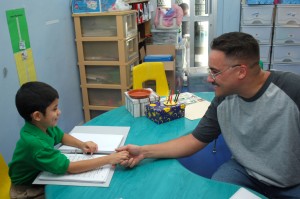Dyspraxia in children is pretty common. It is estimated that at least one child in each class of 30 children will have a dyspraxia diagnosis–in fact somewhere between 5-10% of children have dyspraxia. You are definitely not alone 🙂
Kids with dyspraxia usually exhibit symptoms such as clumsiness, messy handwriting, slow to change for PE, and may fidget a lot–unable to concentrate on a task for any length of time. But that’s a very general overview.
 So why is dyspraxia in children apparently more common than in adults?
So why is dyspraxia in children apparently more common than in adults?
One reason is that we know so much more about dyspraxia now than we did 10, 20, 30… years ago. So there are likely to be just as many adults with dyspraxia as there are children but it went undiagnosed in these adults.
Another reason is that although there is no single cure for dyspraxia, tasks that prove difficult as a child can become easier with practice. So adults have learned ways to cope with the challenges that DCD/dyspraxia brings–so the symptoms are not as obvious in adults as they are in children.
If you take a look at our article on How Does the Mind of a Dyspraxic Child Work? then this might make more sense.
Getting an Early Diagnosis
 When it comes to getting a diagnosis for a child with dyspraxia, then the earlier the better. It is usually picked up in the first year or two of primary school, when children start to develop their social skills and need to complete tasks independently, but sometimes it might not get picked up until they are further on in their schooling. There are degrees of dyspraxia, which might explain why there is a bigger delay in diagnosing some children.
When it comes to getting a diagnosis for a child with dyspraxia, then the earlier the better. It is usually picked up in the first year or two of primary school, when children start to develop their social skills and need to complete tasks independently, but sometimes it might not get picked up until they are further on in their schooling. There are degrees of dyspraxia, which might explain why there is a bigger delay in diagnosing some children.
Many pediatricians are loath to confirm a dyspraxia diagnosis before the age of 5 as with younger children it could just be that they are a little behind in their development. However, childcare professionals are getting much better at recognising conditions such as a dyspraxia even at nursery and preschool age, so if they notify you of their concerns then go to your GP and take early action.
You can find out more about dyspraxia symptoms and getting a diagnosis in this article from our introductory dyspraxia range.
Why Is an Early Diagnosis Important?
 Dyspraxia is caused by the paths of brain cells not reaching the muscles in a smooth way–this is what causes the uncoordinated movements. However, you can teach the cells the path they need to take by repeating tasks over and over, until the path becomes smoother and more natural. So the earlier this is realised, the quicker those smooth paths can be developed.
Dyspraxia is caused by the paths of brain cells not reaching the muscles in a smooth way–this is what causes the uncoordinated movements. However, you can teach the cells the path they need to take by repeating tasks over and over, until the path becomes smoother and more natural. So the earlier this is realised, the quicker those smooth paths can be developed.
Many adults with dyspraxia didn’t even realise they had the condition until they reached adulthood as they have adopted coping mechanisms through the years. But wouldn’t it be nice if your child didn’t have to just cope with it?
An early diagnosis also means that your child can get all the professional help they need to perform those tasks that others just see as a normal.
Treating Dyspraxia
 Your child can expect help from an occupational therapist, as a minimum, but often will get help from a physiotherapist, and maybe an educational psychologist too. These professionals are all great at recommendations for exercises your child can do, equipment they might need, and learning practices to help them in school.
Your child can expect help from an occupational therapist, as a minimum, but often will get help from a physiotherapist, and maybe an educational psychologist too. These professionals are all great at recommendations for exercises your child can do, equipment they might need, and learning practices to help them in school.
You should also expect your dyspraxic child to get supported in their learning at school, often with a teaching assistant, and the teacher can adapt tasks to your child’s needs.
 This is a very general overview of dyspraxia in children, but you can read more about dyspraxia in these introductory articles, or just take a look around the site. Please know that you are not alone, and drop me a line if there’s anything you have questions on that aren’t covered on the site.
This is a very general overview of dyspraxia in children, but you can read more about dyspraxia in these introductory articles, or just take a look around the site. Please know that you are not alone, and drop me a line if there’s anything you have questions on that aren’t covered on the site.
- What Is Dyspraxia?
- Dyspraxia Symptoms – The Good and the Less Good
- Is Dyspraxia a Disability?
- What’s the Difference Between DCD and Dyspraxia?
- How does the Mind of a Dyspraxic Child Work?

 So why is dyspraxia in children apparently more common than in adults?
So why is dyspraxia in children apparently more common than in adults?
My grand daughter age 13 has just been diagnosed with dyspraxia and dislexia. She is in the seventh grade and failing every single subject. I always suspected there was something neuroligically wrong, since her cousins only six weeks older could accomplish tasks such as going up and down stairs, swim and ride a bike while Gillie could not. Is there any connection between dislexia and dyspraxia? If you could send me some information I would appreciate it.
It’s not uncommon for dyslexia and dyspraxia to coexist. The FAQs page has more info on this. She’s not ‘nuerologically wrong’ she’s just different.
I don’t see any mention of Speech therapy.. it is so important to begin therapy with the kids at an early age..
Hi Purvi, this website just concentrates on dyspraxia not verbal dyspraxia/apraxia of speech, so speech therapy isn’t really an issue. I have no expertise in verbal dyspraxia whatsoever so it wouldn’t be right for me to offer advice in this area.